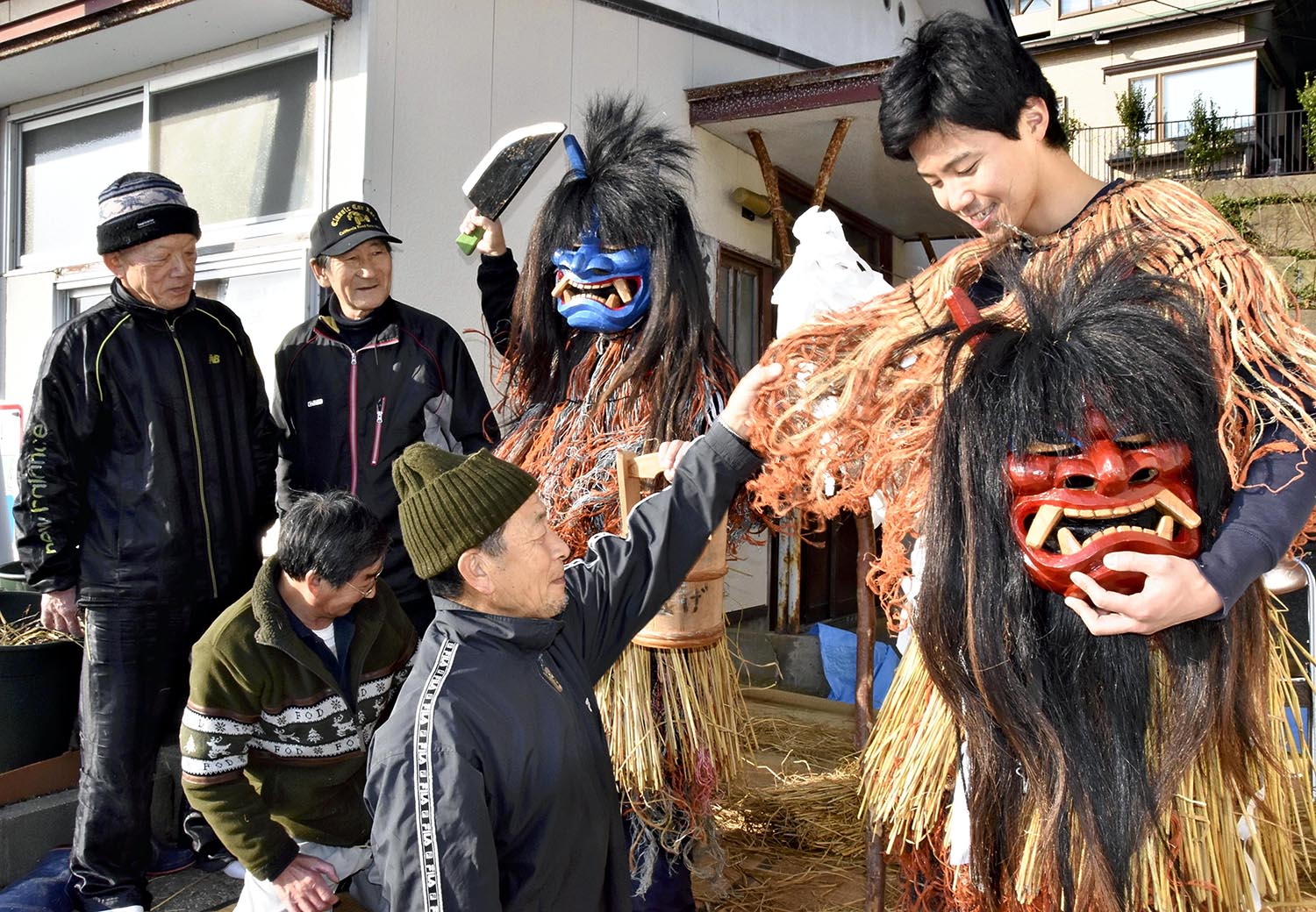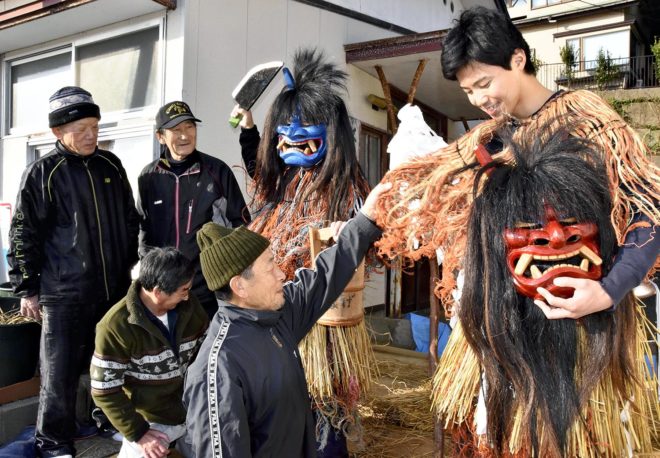AKITA, Japan — A well-known folk event that takes place in a city in Akita Prefecture on New Year’s Eve is facing a shortage of people to carry on the tradition due to the decreasing population and aging society.
Namahage, which takes place in various districts of the city of Oga, was designated by the central government as an important intangible folk culture asset in 1978.
Namahage are demons, traditionally played by local young men. Wearing masks and garments made of straw, they visit houses where children live and shout things like, “Are there any crybabies?”
However, the 56-household Sugoroku district in Oga has allowed young people who are not from the area to be its namahage in order to carry on the tradition.
According to Oga’s board of education, 86 out of 147 neighborhood associations in the city currently hold namahage events. Reasons for not holding one include “a lack of people to perform.” In 1977, more than 95 percent of the city’s neighborhoods held namahage events.
In Sugoroku, which is relatively far from Oga’s city center, the exodus of young people has worsened year after year, with the number of residents in their 20s and 30s falling dramatically. Every year, four namahage — played mostly by men in their 60s or older — visit about 20 households.
Mikio Miura, 68, is in charge of the event in Sugoroku. About 10 years ago, he started worrying that no one will be able to play the namahage in the near future if the situation continues. In a bid to maintain the tradition, he asked the Oga city government to introduce young people who would be willing to play namahage to the neighborhood.
In 2012, a Brazilian and a Uruguayan who were studying at Akita International University in Akita took part in the Sugoroku event. Since then, the district has allowed three or four young people who live outside the city and who are not from Sugoroku to play its namahage.
Last year, Kyosuke Shinoda, a 22-year-old senior at Akita University who is from the area and currently lives in Akita city, brought his friends to the event.
This year, he is set to participate together with another Akita University student living in Akita and a man from Nagasaki Prefecture.
Such moves have sparked criticism from other districts, with one saying, “Why did you allow outsiders to take part in this sacred community event?”
Miura said: “Namahage was inherited from our ancestors. This is why it is most important for it to continue. The move could also lead to people outside the city discovering the attractions of the tradition.”
Shinoda, who will start working next spring, said, “I want to bring my friends [to the event] at the end of each year and continue playing a namahage.”
Miura also kept his spirits high, saying, “For as long as I am well, I’ll never allow the event to be discontinued.”
According to Oga’s board of education, only Sugoroku has regularly accepted “outsiders” to play namahage.
“I hope the move by Sugoroku to accept young people from outside the city spreads widely,” an official of the board of education said.
Other rituals face challenges
The shortage of people to engage in traditional events is posing challenges across the nation.
The Tatemon Festival in Uozu, To- yama Prefecture, dates back about 300 years and is registered on the Unesco intangible cultural heritage list.
The event features seven Tatemon floats that are about 16 meters high and adorned with lanterns and other objects.
Parading one float requires about 100 people. Since 1998, a group of volunteers from outside the prefecture called Tatemon Kyoryokutai has made up for the shortage of manpower. About 300 people from the group participated in the festival this summer.
However, an official of Uozu city’s board of education said: “We are still facing a shortage of people because the outflow of young people hasn’t stopped. Next year, we will have to gather 350 people from outside the prefecture.”
The Kureko Kodai Odori ancient dance from the Gokanosho Kureko district of Yatsushiro, Kumamoto Prefecture, has been designated as a prefectural important intangible folk culture asset. The dance is said to have been started by displaced warriors of the Heike clan.
An association to preserve the tradition that saw the number of its members fall to four began seeking members from outside the district. Six people, including a city government official, have joined and carried on the event.
In Narita, Chiba Prefecture, a form of kabuki called Ino kabuki that is said to have started in 1697 and thrived among farmers had disappeared due to a lack of successors by 1965.
Local people formed a preservation association and revived the kabuki form in 1999, but the members are now aging.














































